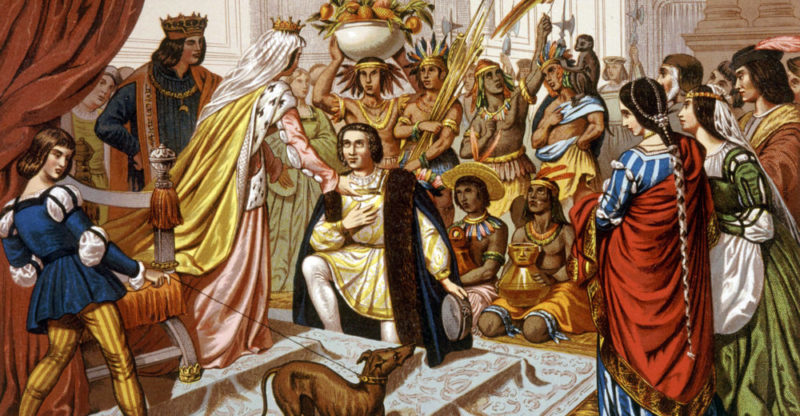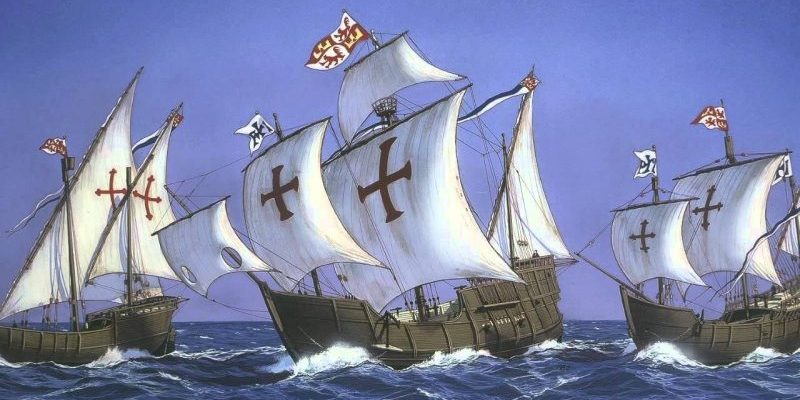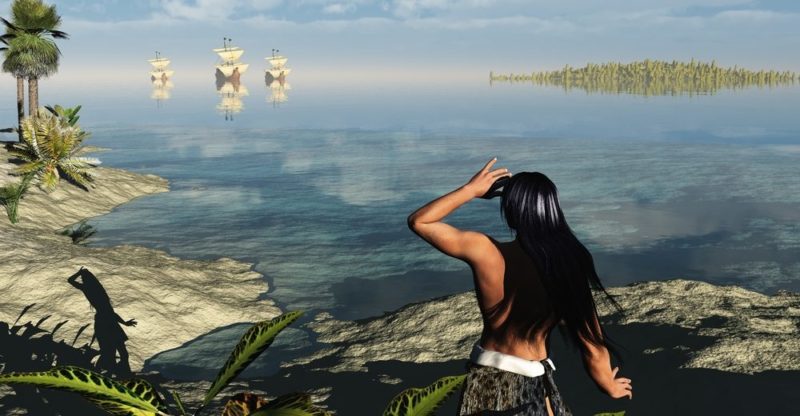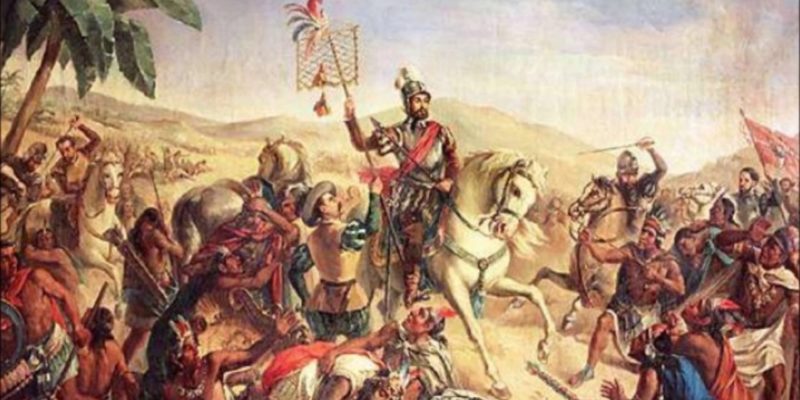We explain to you how was the discovery of America and the changes that this event produced. In addition, its characteristics and consequences.
What was the discovery of America?
The discovery of America occurred in the 15th century, more specifically on October 12, 1492 . A Spanish expedition, commanded by Christopher Columbus, reached the island of Guanahani, which belongs to the Antilles archipelago.
During the 15th century the two European powers were Spain and Portugal , which maintained an intent and fruitful trade with Asia ( India and China ). This trade was carried out by land on the so-called silk route, passing through Muslim territory.
Shortly before the Columbus project, Portugal had started a new sea route around Africa . However, both options were expensive, time-consuming, and dangerous.
Since the spherical shape Earth was known in the most informed circles , the Spanish crown supported Columbus in the project of reaching Asia by surrounding that sphere. However, instead of reaching Asia , the expedition came across an unknown continent that is now called America.
Causes of the discovery of America
European countries needed to find a shorter and cheaper route to maintain trade with Asia. Furthermore, European monarchs suspected that unexplored lands could be found.
Since the Crusades , the exploration had also religious motivations , since it sought to spread Christianity to other societies .
The Christopher Columbus project

Christopher Columbus, whose original name is Critoforo Colombo, was born in 1436 and died in 1506. His goal was to reach Japan, at that time land of the Great Khan , to facilitate the trade in silk and highly valuable spices.
For this he obtained a map by Paolo dal Pozzo Toscanelli that, based on Marco Polo's travels, indicated the route that allowed him to travel from Europe to Asia, stopping at various islands that were supposedly on the way.
This project was presented on numerous occasions to the King of Portugal and the Kings of Spain before the latter accepted. His detractors pointed out that the trip was impossible because the distances were much greater than those calculated by Columbus.
The first trip

The departure was on August 3, 1492 , from the Port of Palos, with a last stop in European territory on September 6, 1492, on the island of La Gomera (Canary Islands). The arrival was on October 12, 1492 and Rodrigo de la Triana was the sailor who sighted the land.
Columbus expected to reach Asia because he did not know that traveling in that direction he was 19,000 kilometers from his starting point (4 times more than calculated)
Three vessels arrived in America:
- Santa Maria. It is believed that it was not a caravel, it was the flagship and had more than thirty crew members.
- The Pinta. Caravel carrying approximately twenty-five crew members.
- The girl. Caravel carrying less than twenty crew members.
Second trip
The second voyage began on September 25, 1493 and the return was on June 11, 1496 . The lands discovered on this trip were islands, including Jamaica and Puerto Rico. On this trip the colonization process began.
Third travel
The third voyage began on May 30, 1498, and the return was on November 25, 1500 . This was the journey in which what is now Venezuela was reached and for the first time the Europeans reached the American continental mass.
Conquest and colonization of America

The conquest and colonization extended from the end of the 15th century , with the discovery, until the first wars of independence in the late 18th and early 19th centuries. The conquest of the new territories was facilitated by various causes.
- The Europeans had more effective weapon technology than the Native Americans.
- Europeans used horses as war and pack animals .
- The Americans had no defenses against the diseases that the Europeans brought.
- Various American peoples were at odds with each other, which in some cases facilitated the triumph of a unified foreign force.
After Columbus

The colonization of America was in charge of different conquerors:
- Hernán Cortés . At the beginning of the 16th century, the conquest of the territory that is currently Mexico began . He dominated and put an end to the Mexica empire with the strategy of allying with certain indigenous groups against others.
- Francisco Pizarro. He conquered the current territory of Peru , defeating the Inca Empire .
- Hernando de Soto. Starting in 1539, the conquest of what is now Florida began.
- Álvaro Núñez Cabeza de Vaca. He explored the current area of Alabama, Mississippi and Louisiana, conquering northern Mexico and Baja California, in the mid-16th century.
Consequences for Europe
The discovery of America unleashed some relevant events for Europe such as:
- Emigration of European population to America
- Arrival of new riches
- Inflation
- Establishment of new maritime empires for Spain and Portugal.
- New consumer products such as tobacco, coffee , sugar , potatoes and tomatoes.
- New navigation routes through the Atlantic Ocean , which caused the Mediterranean routes to partially lose their commercial importance, causing the decline of Mediterranean cities .
Consequences for America

During the conquest, the American peoples lost their material (rubber, gold , silver , wood ) and cultural (buildings, arts , language , religion) wealth .
Local cultures like language , religion, and dress were replaced by European ones .
From then on, most of the native population went to live in a state of slavery or servitude . In addition, when exposed to new diseases, a high mortality rate was recorded.
America: before and after the discovery
Before the discovery, the towns used a great variety of languages. As for religion, they believed in gods of nature.
- Cultivating peoples. They lived in villages and fed on corn , beans, cassava and also on hunting and fishing.
- Hunter-gatherer peoples. They fed on animals, roots, fruits and seeds. They were nomads: they united in small groups that moved from one place to another.
- Until 1547, Spain did not allow women to travel to America, so Spanish men had children with native women and some lived with them, forming families.
- African men and women were brought to America as slaves.
- Native populations were decimated, few of their original settlements survived, and they were forced to change their customs and social structure.
- Throughout America, four official languages were established: Spanish, Portuguese, English, and French.
The above content published at Collaborative Research Group is for informational and educational purposes only and has been developed by referring reliable sources and recommendations from technology experts. We do not have any contact with official entities nor do we intend to replace the information that they emit.
Cultural journalist with great interest in education and technological innovation in the classroom. The future passes through technology and it is already here. .
Leave a reply
Your email address will not be published. Required fields are marked *Recent post

Sport: What Is It, Types, Risks, Features, Characteristics and Examples

Dogs: Emergence, Features, Characteristics, Feeding and Breeds

Story: Definition, Elements, Structure, Features and Characteristics

